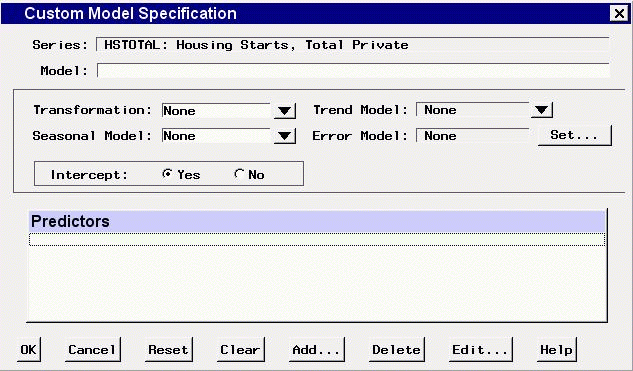Custom Model Specification Window
Use the Custom Model Specification window to specify and fit an ARIMA model
with or without predictor effects as inputs.
Access it from the Develop Models window,
where it is invoked from the Fit Model item under the Edit pull-down menu,
or from the pop-up menu when you click an empty area of the model table.

Controls and Fields
- Series
-
is the name and variable label of the current series.
- Model
-
is a descriptive label for the model that you specify.
You can type a label in this field or allow the system to provide a label.
If you leave the label blank,
a label is generated automatically based on the options you specify.
- Transformation
-
defines the series transformation for the model.
When a transformation is specified, the model is fit to the transformed
series, and forecasts are produced by applying the inverse transformation to
the resulting forecasts.
The available transformations are:
- Log
-
specifies a logarithmic transformation.
- Logistic
-
specifies a logistic transformation.
- Square Root
-
specifies a square root transformation.
- Box-Cox
-
specifies a Box-Cox transform and brings up a window to
specify the Box-Cox
 parameter.
parameter.
- None
-
specifies no series transformation.
- Trend Model
-
controls the model options to model and forecast the series trend.
Select from:
- Linear Trend
-
adds a Linear Trend item to the Predictors list.
- Trend Curve
-
brings of a menu of different time trend curves
and adds the curve you select to the Predictors list.
- First Difference
-
specifies differencing the series.
- Second Difference
-
specifies second-order differencing of the series.
- None
-
specifies no model for the series trend.
- Seasonal Model
-
controls the model options to model and forecast the series seasonality.
Select from:
- Seasonal ARIMA
-
brings up the Seasonal ARIMA Model Options window to enable you to
specify an ARIMA model for the seasonal pattern in the series.
- Seasonal Difference
-
specifies differencing the series at the seasonal lag.
- Seasonal Dummy Regressors
-
adds a Seasonal Dummies predictor item to the Predictors list.
- None
-
specifies no seasonal model.
- Error Model
-
displays the current settings of the autoregressive and moving average
terms, if any, for modeling the prediction error autocorrelation pattern in the
series.
- Set button
-
brings up the Error Model Options window to let you set the
autoregressive and moving average
terms for modeling the prediction error autocorrelation pattern in the
series.
- Intercept
-
The options Yes and No enable you to specify whether
a mean or intercept parameter
is included in the model.
By default, the Intercept option is set to No
when the model includes differencing
and set to Yes when there is no differencing.
- Predictors
-
is a list of the predictor effects included as inputs in the model.
- OK
-
closes the Custom Model Specification window and fits the model.
- Cancel
-
closes the Custom Model Specification window without fitting the model.
Any options you specified are lost.
- Reset
-
resets all options to their initial values upon entry to the
Custom Model Specification window.
This may be useful when editing an existing model specification;
otherwise, Reset has the same function as Clear.
- Clear
-
resets all options to their default values.
- Add
-
brings up a menu of types of predictors to add to the Predictors list.
Select from:
- Linear Trend
-
adds a Linear Trend item to the Predictors list.
- Trend Curve
-
brings up a menu of different time trend curves
and adds the curve you select to the Predictors list.
- Regressors
-
brings up the Regressors Selection window
to enable you to select other series in the input data set
as regressors to predict the dependent series
and add them to the Predictors list.
- Adjustments
-
brings up the Adjustments Selection window
to enable you to select other series in the input data set
for use as adjustments to the forecasts
and add them to the Predictors list.
- Dynamic Regressor
-
brings up the Dynamic Regressor Selection window
to enable you to select a series in the input data set
as a predictor of the dependent series
and also specify a transfer function model
for the effect of the predictor series.
- Interventions
-
brings up the Interventions for Series window
to enable you to define and select intervention effects
and add them to the Predictors list.
- Seasonal Dummies
-
adds a Seasonal Dummies predictor item to the Predictors list.
This is grayed out if the series interval is not one which has
a seasonal cycle.
- Delete
-
deletes the selected (highlighted) entry from the Predictors list.
- Edit
-
edits the selected (highlighted) entry in the Predictors list.
Mouse Button Actions
You can select or deselect entries in the Predictors list by
positioning the mouse cursor over the entry and clicking the left mouse button.
The selected (highlighted) predictor effect
is acted on by the Delete and Edit buttons.
Double-clicking on a predictor in the list invokes an appropriate edit action
for that predictor.
If you position the mouse cursor over the Predictors list
and press the right mouse button, the system displays a menu of actions
encompassing the features of the Add, Delete, and Edit buttons.
Copyright © 1999 by SAS Institute Inc., Cary, NC, USA. All rights reserved.
